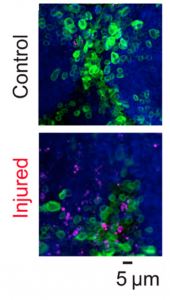Despite decades of research, it is still not clear how chronic pain develops, why it prevails, and how best to treat the underlying pathology. In a paper published in the journal Science Advances, Dr Thang Khuong and A/Prof. Greg Neely at the University of Sydney report on their in-depth study to investigate the evolution of chronic pain using the fruit fly, Drosophila.

Higher levels of active caspase (pink) in injured flies. This protein is responsible for the death of pain inhibiting nerve cells.
The underlying mechanisms causing chronic “pain” in flies were studied by using a combination of behavioural, genetic and microscopic analyses. They found that pain killing nerve cells in the insects’ ventral nerve cord, the insect equivalent of our spinal cord, were lost. Similar observations have been made in mice and human chronic pain patients. The protein stained pink in the confocal microscopy image of a Drosophila “spinal cord” is active caspase, and this is responsible for the loss of those pain killing nerve cells, resulting in neuropathic “pain”. These data establish that chronic pain was actually advantageous at some point in evolution, however in modern humans, chronic pain is now a liability.
Now that the core mechanism causing chronic pain has been identified, new therapies targeting the underlying cause of chronic pain are being developed by Neely and his team.
Ventral nerve cord (equivalent to the human spinal cord) of an uninjured fly with the pain nerve cell projections shown in green, pain inhibiting neural transmitters in red and neural synapses in yellow.
August 26, 2019